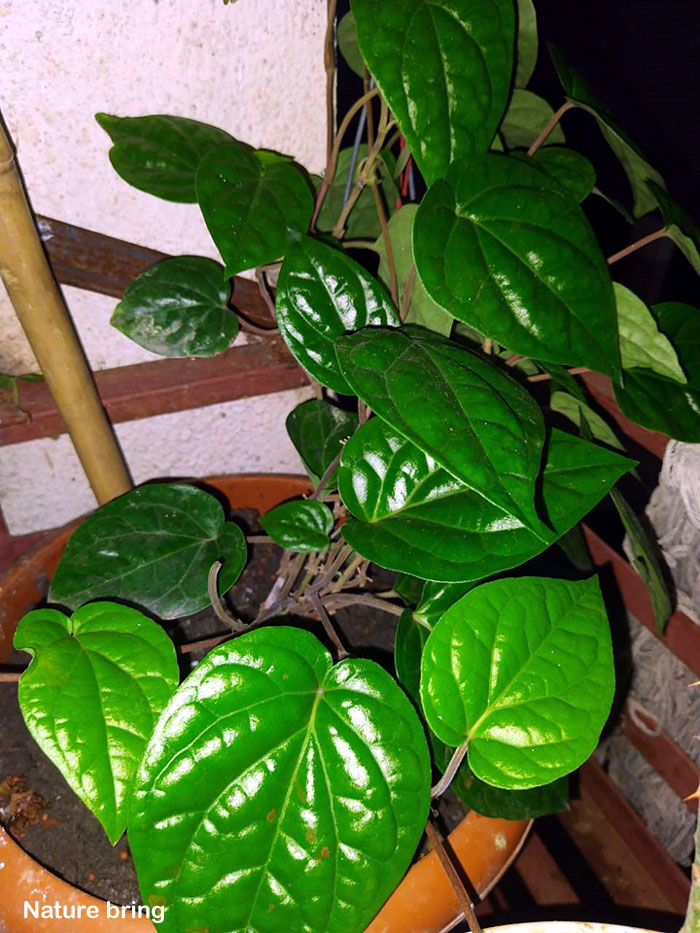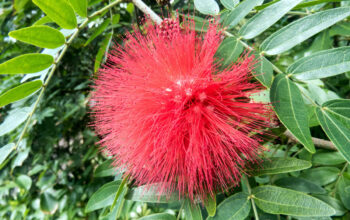Betel Leaf (Paan)
How to grow betel leaf plant | Growing Betel Leaf (Paan). A gorgeous plant that thrives in low light and tolerates soggy feet, the betel plant (Piper betel) — is also referred to as paan. It is an essential plant in Ayurvedic tradition typically recommended as a stimulant, a general health tonic, and a breath freshener. The paan leaf plays a vital role in Indian culture, and Hindus often wrap money in betel leaves before giving it to their priests.
Importance of betel leaf (piper betel)
Betel leaf (paan leaf) is traditionally served after Indian meals because it’s believed to assist digest curried food and act as a mouth freshener. Betel leaf can wrap around spices like cardamom, anise, lime paste, or grated coconut. Since toothpicks are a relatively new invention, Indians traditionally seal the wrapped betel leaf with a clove.
About piper betel
Betel leaf is a vine plant, it is grown to climb up a tree or fence during the summer or trained to spill over the edge of a pot in a hanging basket. It proliferates but appears to grow most quickly within the warm temperatures and long days of summer. Betel leaf will need protection from freezing temperatures but is an especially attractive house plant with large heart-shaped, glossy leaves.
How to grow Betel Leaf plant (Paan)
The Betel leaf Plant is an herb that’s a member of the Piperaceae. The Paan leaf plant is a versatile plant used for cooking and medicine. it’s native to India, where it’s widely known for its use in making a famous Indian dessert Paan.
This healthy herb is suitable to grow in containers and hanging baskets. However, since it originates from Asia, it’s difficult to find its seed and grow it from the seeds. Therefore, it’s better to grow it from root division or cutting. Furthermore, it’s a versatile herb that may develop in cold and hot climates.
But before learning how to grow a betel leaf plant, you must also know why to grow it. People are increasingly growing the betel leaf plant for its beneficial effects on health. Chewing paan leaf plants alone will improve digestion, prevent carcinogenesis of the oral fissure, helps maintain proper oral hygiene, treat a wart, cough, and headache, and Cure constipation. Learning how to grow a Betel leaf plant isn’t difficult as long as you have adequate requirements.
Soil
This plant requires acidic, sandy, and slightly moist soil, it grows rapidly in this soil. If you want to grow this herb in a container, you can choose a big, deep, and wide container. Confirm whether your pot has a suitable hole or not for drainage, this is necessary to keep the soil well-drained. Now for this, you choose a partially shady place.
Growing habit
The herb’s main stem grows up to 1 meter tall. Thus, it’s better to train it as a climber or a ground cover. Once it grows tall enough, it’ll form creeping stems with leaves on the shape of hearts. These leaves contain mild scents and white flowers if you crush them, they’re going to exude a fresh peppery scent.
Propagation
- Since it’s tough to return across betel leaf seeds, you can develop paan plants either you buy the plant from your local nursery or propagate from plant cuttings.
- To apply the cuttings, cut a healthy stem about 18 cm long from the betel plant and use a sharp knife to cut the stem from the bottom of the leaf node by 45 degrees.
- Then you must remove all the leaves off their stem apart from the highest two.
- Once your cutting prepared, soak it in water and place it on a windowsill where it can get indirect sunlight. You must change the water every few days. Once the roots appear, you’ll plant it in a deep pot or within the ground.
Care of Betel leaf plant
- It prospers well in a humid and hot environment in partial shade. The betel plant needs regular watering.
- Prune regularly after it reaches 2 m. height to manage the plant, proper pruning and plucking of leaves encourage new growth and sweet and tender leaves.
- It usually recommended that occasional feeding every few months within the plant’s season with a nitrogen-rich organic fertilizer like manure or compost.
- Keep it indoors in winters when the temperature starts to fall below 41F (5C) in a warm and cozy room under grow light.
- It becomes drowsing in brutal cold temperature, and sometimes it leads to abscission, but get to grow again in spring and remains in growth until fall.
Read also:
Growing orchids flowers at home. Growing Petunia in containers. How to grow Vinca flowers. Coreopsis Growing Tickseed. Chickpeas growing and care tips. Yesterday, today and tomorrow plant. How to Grow Love-in-a-Mist plants. Pak choi vegetable growing tips. Aster flowers growing guide. Hyacinth bulb growing and care guide. Homemade rooting hormones. Cinnamon plants growing in containers. Watermelon growing and care guide.
For Pin








